Study on the Damage Mechanism of Bank Slope-Bridge Pile Foundation Interaction under Reservoir Water Level Cycle
Abstract
:1. Introduction
2. FEM-SPH Conversion Coupling Algorithm
2.1. FEM-SPH Coupling Algorithm
2.2. FEM-SPH Conversion Principle
3. Finite Element Model of Bank Slope-Bridge Pile Foundation Interaction under Reservoir Water Level Cycling Conditions
3.1. Bridge Project Background
3.2. Three-Dimensional Bank-Bridge Finite Element Model
3.2.1. Structural Dimensions and Boundary Loads
3.2.2. Element and Grid Division
3.2.3. Constitutive Parameter
4. Analysis of Damage Mechanisms Caused by Bank Slope-Bridge Pile Foundation Interaction under the Condition of Reservoir Water Level Circulation
4.1. Bank Slope Stability Analysis
4.2. Analysis of Pier Deformation Characteristics
4.2.1. Comparison between Numerical Simulation and Engineering Measurement
4.2.2. Displacement and Deformation Characteristics of the Pier
5. Failure Mode of Bank Slope-Bridge Pile Foundation Interactions under Reservoir Water Level Cycling Conditions
6. Comprehensive Reinforcement Treatment Method
6.1. An Additional Anti-Slip Pile Reinforcement Method Is Used for Bank Slip
6.2. The Main Girder Jacking Correction Method Is Used for Bridge Pier and Main Girder Deflection Disease
6.3. The Pier Body Disease Using the Increased Section Treatment Method
6.4. An Additional Pile Reinforcement Method Is Used for Foundation Damage
6.5. Comprehensive Reinforcement Effect Analysis
7. Conclusions
- (1)
- The FEM-SPH conversion coupling algorithm can simulate the whole slope process, from the initial deformation slip to the deterioration of geotechnical properties leading to the final instability. It is more intuitive and accurate than the traditional criterion by completely converting the finite element mesh of the sliding area into SPH particles as the slope instability criterion;
- (2)
- The first instability damage will occur during the 16th water level lift cycle. In the 17th to 19th water level lift cycles, the slope is in a new steady state, but the unbalanced soil thrust on the pile foundation gradually increases, and the bridge pile foundation plays an anti-slip role in the slope deformation instability during the 20th water level lift cycle. The second type of instability damage will occur;
- (3)
- The overall deformation of the pile pier is characterized as follows: the displacement of the pile body in the bedrock embedded section is almost zero; the pile body is displaced horizontally from the soil-rock interface to the pile-soil interface; and the displacement of the pile body is linearly increasing from the pile-soil interface to the top of the pier. With the deformation, slippage, and instability of the slope, the deflection of the top of the pier shows a trend of “slow increase-surge”, and the increment of the deflection changes from slow increase to surge during the first destabilization of the bank slope;
- (4)
- Pile damage and cracking occur first at the soil-rock interface of the pile foundation and then gradually develop upward; with the deformation and destabilization of the bank slope under the action of the reservoir water level cycle, the pile foundation develops from transverse cracks to mixed cracks until the second destabilization of the bank slope occurs in the process of damage, the pile foundation tensile area fails on a large scale, shear damage occurs at the upper part of the soil-rock interface, and the angle between the damage surface and the horizontal plane is about 60°. Therefore, during the operation of the bridge, the structural performance monitoring at the soil-rock interface of the pile foundation should be strengthened, and the later remediation should focus on the reinforcement treatment at this location;
- (5)
- By relying on the bridge rescue project for the Three Gorges reservoir area landslide, the comprehensive reinforcement treatment method of the bridge structure was studied. The deflection of piers and main girders was corrected by jacking the main girders, piers were treated by increasing the cross-section; foundations were reinforced by adding pile foundations; and bank slips were reinforced by adding anti-slip piles. After adopting the comprehensive reinforcement treatment described in this paper, the bridge pier of a Yangtze River Bridge in the reservoir area has a good restoration effect, among which pier six has the most obvious treatment effect. The top upstream and downstream sides of the pier are restored to 33.5 cm and 33.0 cm, respectively, and the bottom upstream and downstream sides of the pier near the ground are restored to 5.1 cm and 4.2 cm, respectively. After the soil removal and anti-slip pile reinforcement treatment, the bank slope is in a stable state. Through reinforcement measures such as adding a pile foundation, enlarging the bearing platform, and expanding the pier section, the bearing capacity and stability of the substructure were greatly improved. The bridge inspection and monitoring results show that the above methods are effective for the reinforcement and treatment of landslide-damaged bridges.
Author Contributions
Funding
Data Availability Statement
Acknowledgments
Conflicts of Interest
References
- Deng, H.F.; Zhou, M.L.; Li, J.L.; Sun, X.S.; Huang, Y.L. Creep degradation mechanism by water-rock interaction in the red-layer soft rock. Arab. J. Geosci. 2016, 9, 601. [Google Scholar] [CrossRef]
- Huang, D.; Gu, D.M. Influence of filling-drawdown cycles of the Three Gorges reservoir on deformation and failure behaviors of anaclinal rock slopes in the Wu Gorge. Geomorphology 2017, 295, 489–506. [Google Scholar] [CrossRef]
- Wang, H.L.; Xu, W.Y. Stability of Liangshuijing landslide under variation water levels of Three Gorges Reservoir. Eur. J. Environ. Civ. Eng. 2013, 17 (Suppl. 1), s158–s177. [Google Scholar] [CrossRef]
- Wang, H.B.; Sassa, K. Rainfall-induced landslide hazard assessment using artificial neural networks. Earth Surface Process. Landf. 2006, 31, 235–247. [Google Scholar] [CrossRef]
- Wu, S.R.; Shi, L.; Wang, R.J.; Tan, C.X.; Hu, D.G.; Mei, Y.T.; Xu, R.C. Zonation of the landslide hazards in the forereservoir region of the Three Gorges Project on the Yangtze River. Eng. Geol. 2001, 59, 51–58. [Google Scholar] [CrossRef]
- Ding, X.L.; Fu, J.; Zhang, Q.H. Stability analysis of landslide in the south end of Fengjie Highway Bridge with fluctuation of water level of Three Gorges Reservoir. Chin. J. Rock Mech. Eng. 2004, 17, 2913–2919. [Google Scholar]
- Miao, F.S.; Wu, Y.P.; Li, L.W.; Tang, H.M.; Li, Y.N. Centrifuge model test on the retrogressive landslide subjected to reservoir water level fluctuation. Eng. Geol. 2018, 245, 169–179. [Google Scholar] [CrossRef]
- Kafle, L.; Xu, W.J.; Zeng, S.Y.; Nagel, T. A numerical investigation of slope stability influenced by the combined effects of reservoir water level fluctuations and precipitation: A case study of the Bianjiazhai landslide in China. Eng. Geol. 2022, 297, 106508. [Google Scholar] [CrossRef]
- Xue, Y.; Miao, F.S.; Wu, Y.P.; Dias, D. Dynamic stability assessment of reservoir colluvial landslide using a hypoplastic clay constitutive model considering the effects of drying-wetting cycles on the hydro-fluctuation belt. Eng. Geol. 2022, 307, 106791. [Google Scholar] [CrossRef]
- Wang, H.Y. Study on Stability of High and Steep Slope in Mountain Reservoir. Build. Struct. 2017, 47, 486–490. [Google Scholar]
- Liu, D.Z.; Hu, X.L.; Zhou, C.; Xu, C.; He, C.C.; Zhang, H.; Wang, Q. Deformation mechanisms and evolution of a pile-reinforced landslide under long-term reservoir operation. Eng. Geol. 2020, 275, 105747. [Google Scholar] [CrossRef]
- Muszyński, Z.; Rybak, J. Horizontal Displacement Control in Course of Lateral Loading of a Pile in a Slope. IOP Conf. Ser. Mater. Sci. Eng. 2017, 245, 032002. [Google Scholar] [CrossRef]
- Kozubal, J.; Pula, W.; Wyjadlowski, M.; Bauer, J. Influence of varying soil properties on evaluation of pile reliability under lateral loads. J. Civ. Eng. Manag. 2013, 19, 272–284. [Google Scholar] [CrossRef] [Green Version]
- Diao, X.H.; Zhu, C.; Yu, Y.; Mao, X.B. Analysis of deformation characteristics of anti-slide piles under the action of seepage force. Sci. Technol. Eng. 2017, 17, 133–138. [Google Scholar]
- Sawant, V.A.; Shukla, S.K. Effect of Edge Distance from the Slope Crest on the Response of a Laterally Loaded Pile in Sloping Ground. Geotech. Geol. Eng. 2014, 32, 197–204. [Google Scholar] [CrossRef]
- Xing, L.; Wang, D.Y.; Duan, L.L.; Wang, L. Lateral cumulative displacement of wharf pile group under wetting-drying cycles and horizontal cyclic loading. Sci. Technol. Eng. 2021, 21, 8166–8175. [Google Scholar]
- Liu, A. Study on the force performance of bridge foundation across the reservoir area. Highway 2022, 67, 243–248. [Google Scholar]
- Zhou, G.P. Study on Damage Mechanism and Maintenance Method of Bridge Substructure under Loading Reservoir Bank Landslide. Master’s Thesis, Chongqing Jiaotong University, Chongqing, China, 2020. [Google Scholar]
- Xia, C.Z.; Shi, Z.M.; Zheng, H.C. An improved smooth particle hydrodynamics method for modelling crack propagation in layered rock cells and slopes. Bull. Eng. Geol. Environ. 2023, 82, 129. [Google Scholar] [CrossRef]
- Fang, J.N.; Parriaux, A.; Rentschler, M.; Ancey, C. Improved SPH methods for simulating free surface flows of viscous fluids. Appl. Numer. Math. 2008, 59, 251–271. [Google Scholar] [CrossRef] [Green Version]
- Hu, M.; Gao, T.; Dong, X.W.; Tan, Q.T.; Yi, C.; Wu, F.; Bao, A.H. Simulation of soil-tool interaction using smoothed particle hydrodynamics (SPH). Soil Tillage Res. 2023, 229, 105671. [Google Scholar] [CrossRef]
- GB 50010-2010; Code for Design of Concrete Structures. China Architecture & Building Press: Beijing, China, 2015.
- Tu, Y.L.; Liu, X.R.; Zhong, Z.L.; Wang, S.; Wang, Z.J.; Ke, W. Experimental study on strength and deformation characteristics of silty clay during wetting-drying cycles. Rock Soil Mech. 2017, 38, 3581–3589. [Google Scholar]
- Zhou, Y.F.; Deng, J.H.; Cui, Y.L.; Zheng, H.C.; Chen, T. Instability Criterion of Three-Dimensional Slope Based on Strength Reduction Method. Rock Soil Mech. 2014, 35, 1430–1437. [Google Scholar]
- Li, J.; Chen, S.X.; Yu, F.; Jiang, L.F. Reinforcement Mechanism and Optimisation of Reinforcement Approach of a High and Steep Slope Using Prestressed Anchor Cables. Appl. Sci. 2019, 10, 266. [Google Scholar] [CrossRef] [Green Version]
- Galli, A.; di Prisco, C. Displacement-based design procedure for slope-stabilizing piles. Can. Geotech. J. 2013, 50, 41–53. [Google Scholar] [CrossRef]
- Kourkoulis, R.; Gelagoti, F.; Anastasopoulos, I.; Gazetas, G. Slope stabilizing piles and pile-groups: Parametric study and design insights. J. Geotech. Geoenvironmental Eng. 2011, 137, 663–677. [Google Scholar] [CrossRef] [Green Version]
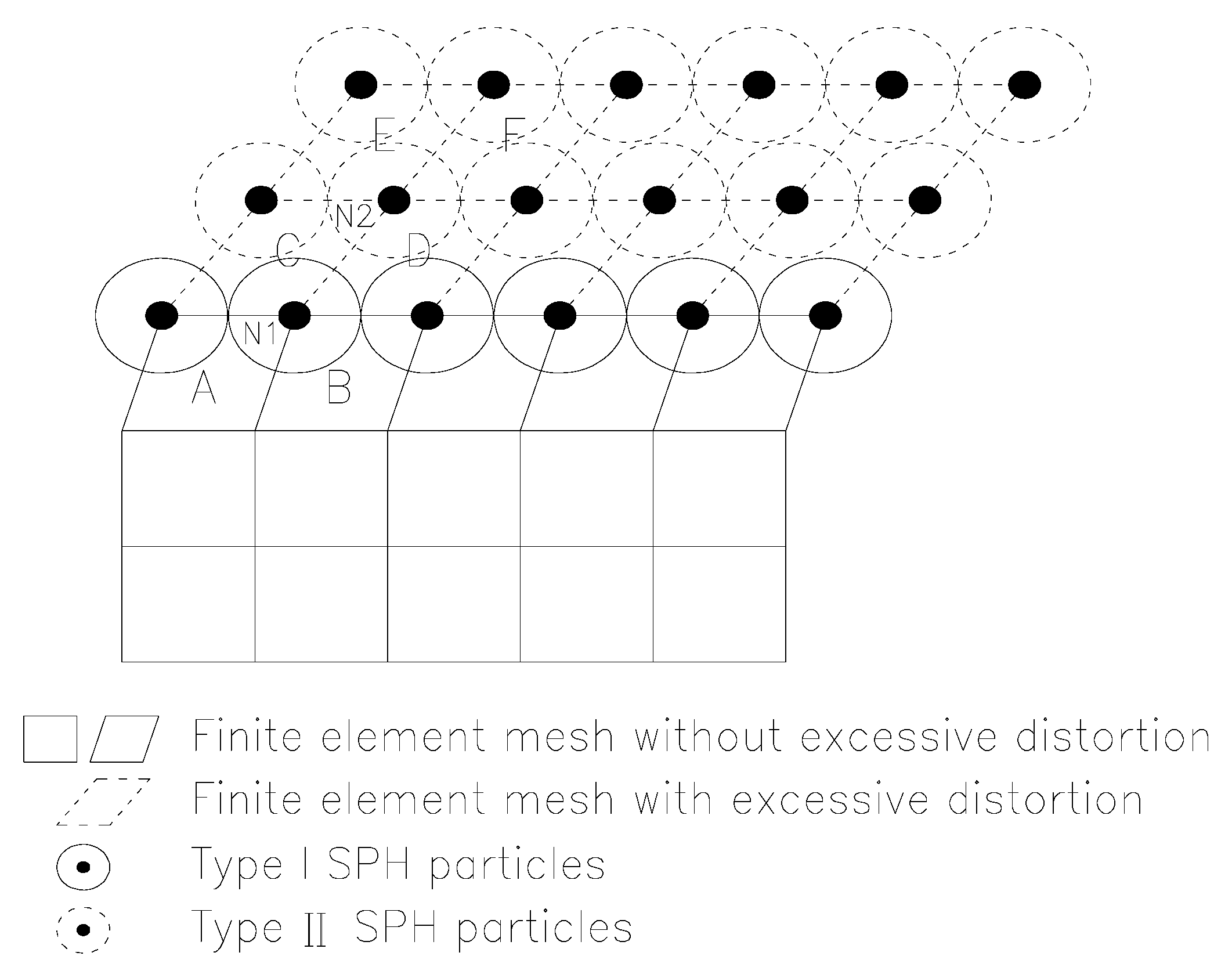

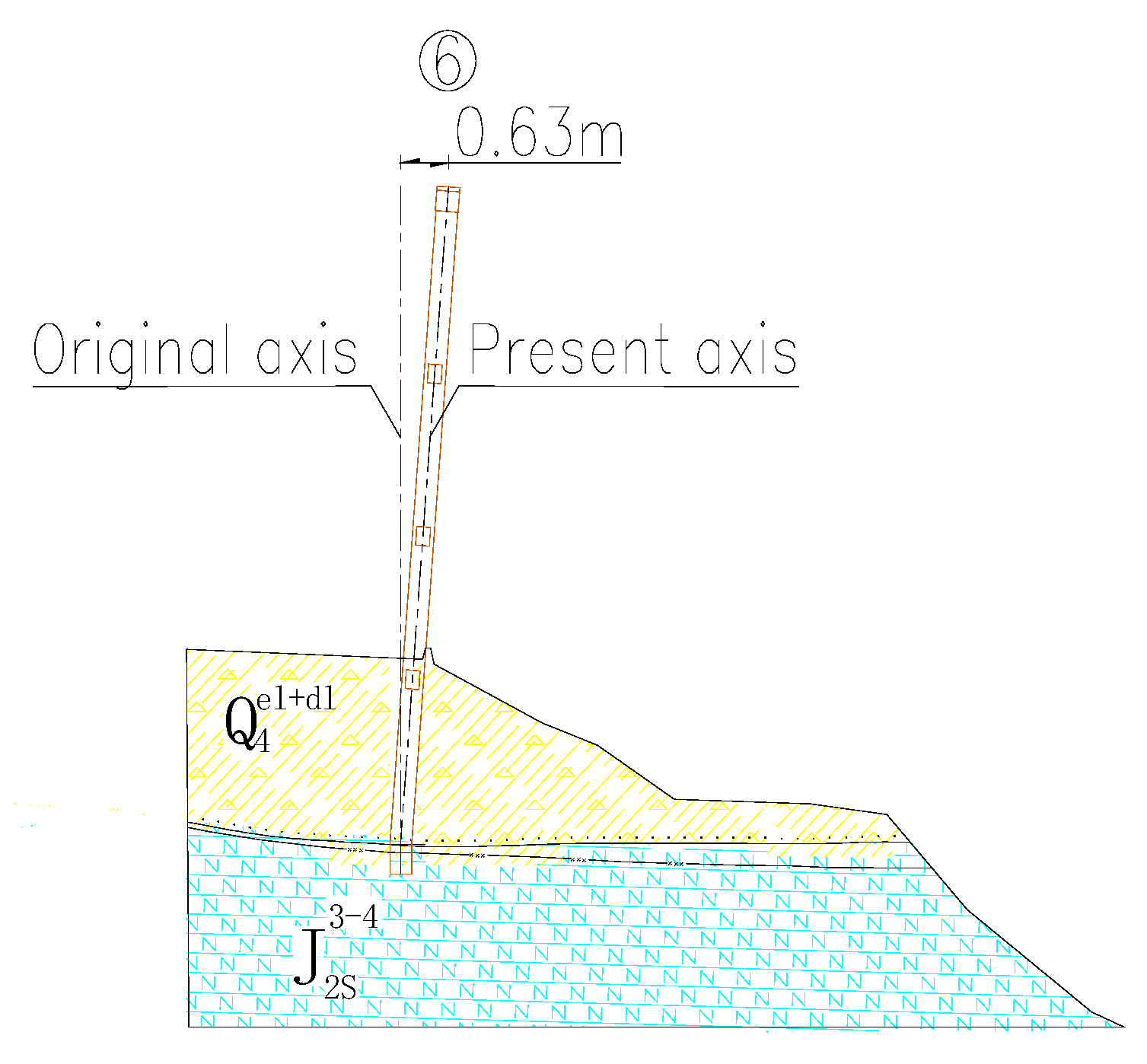
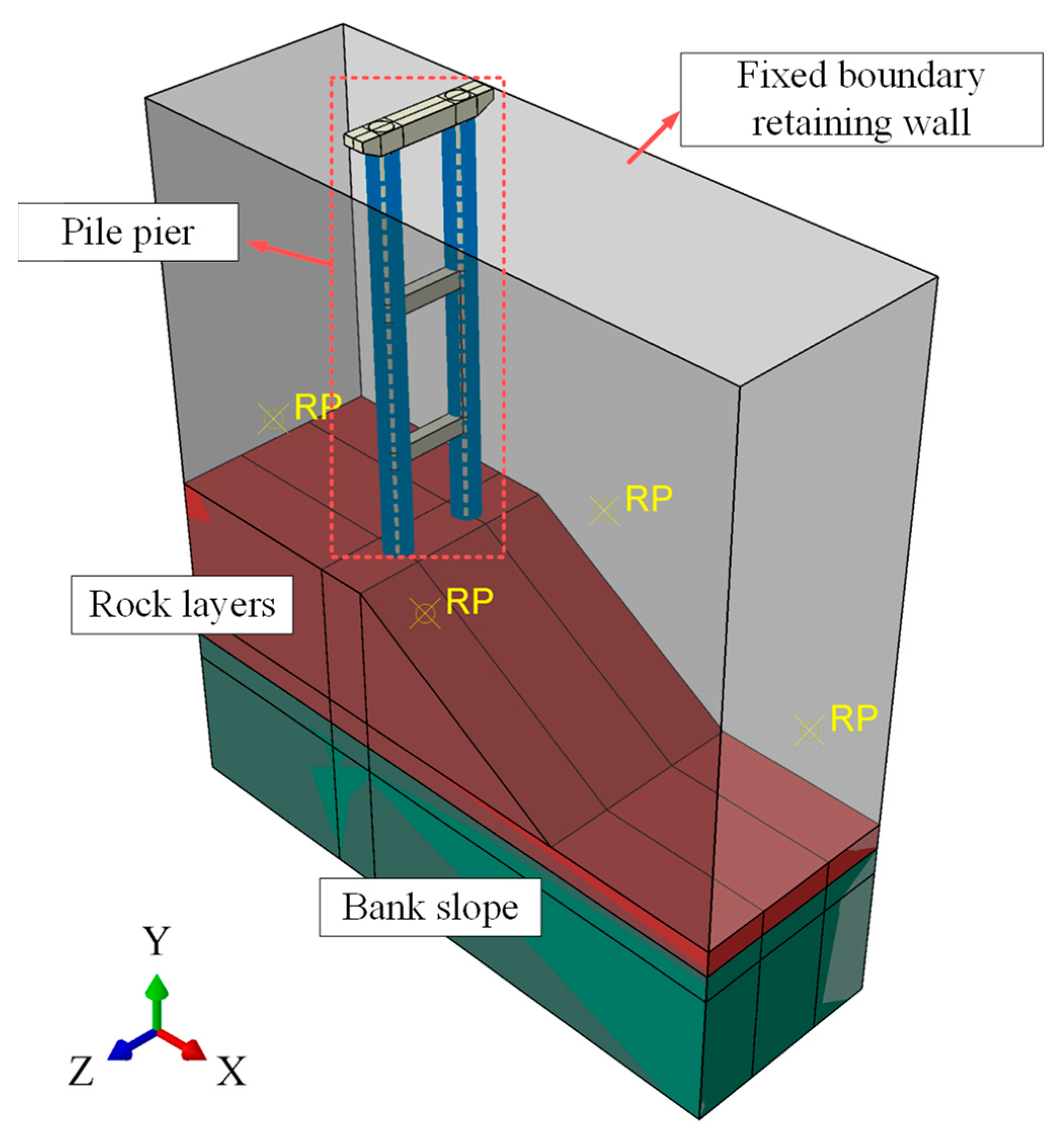

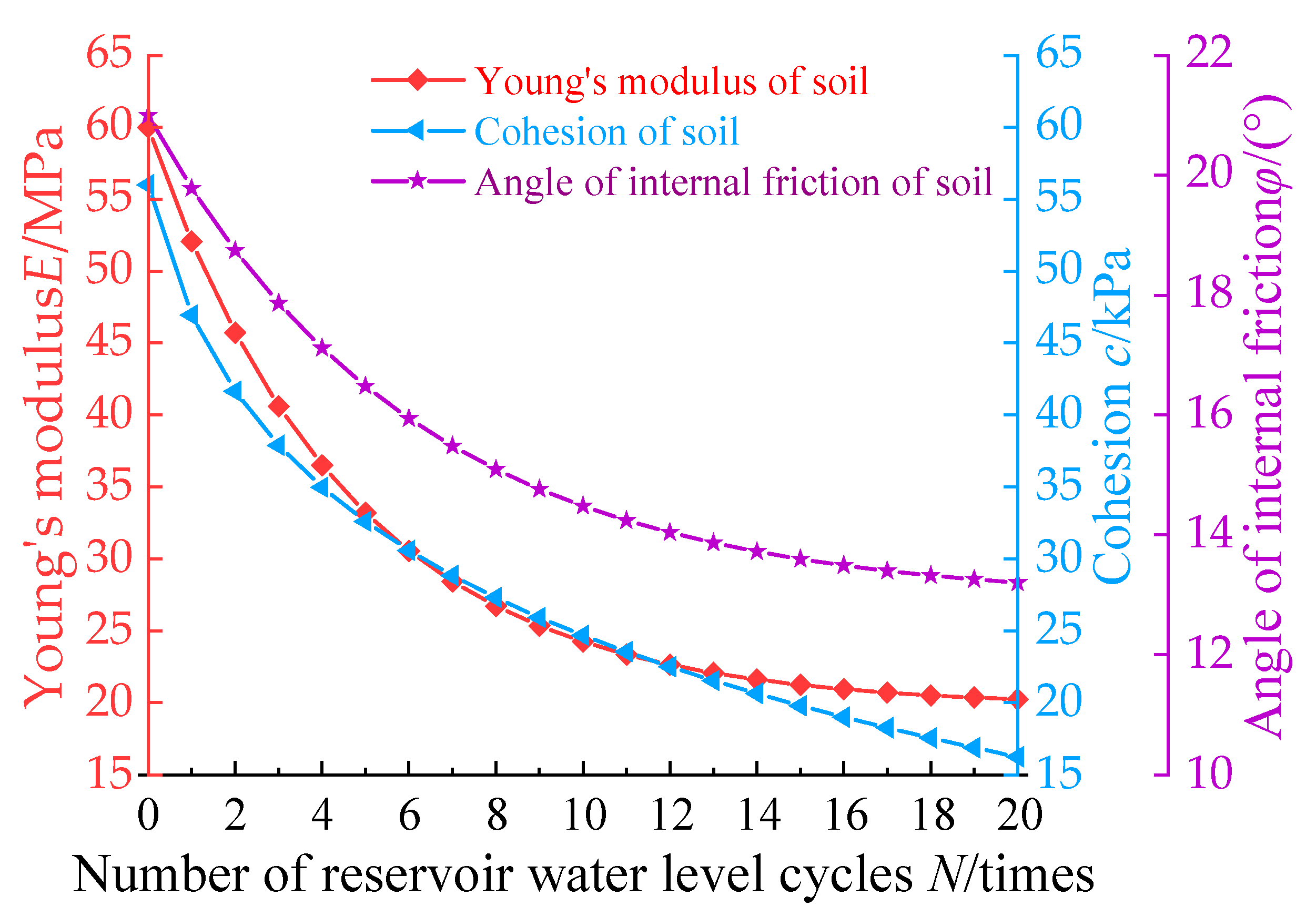
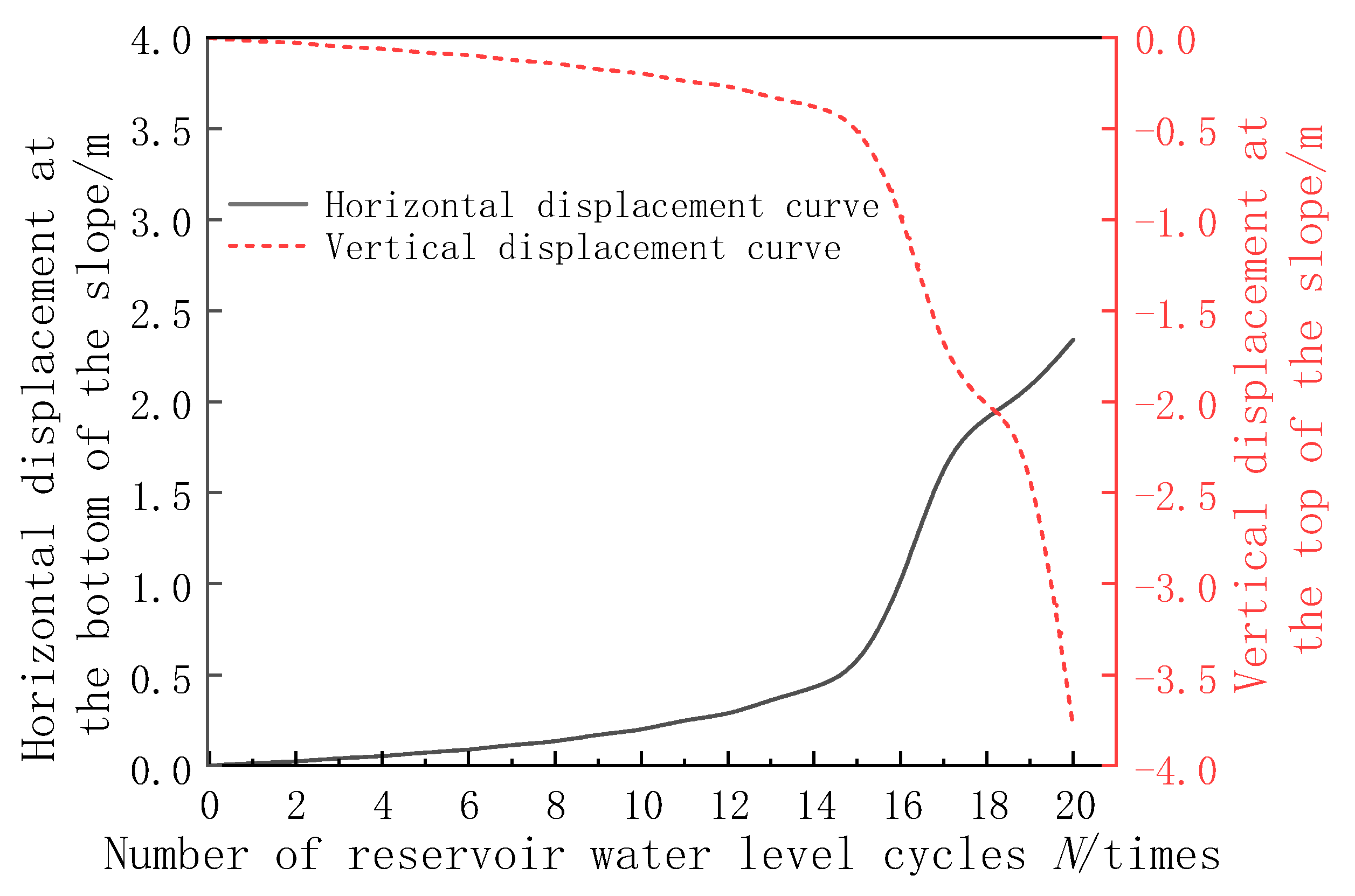

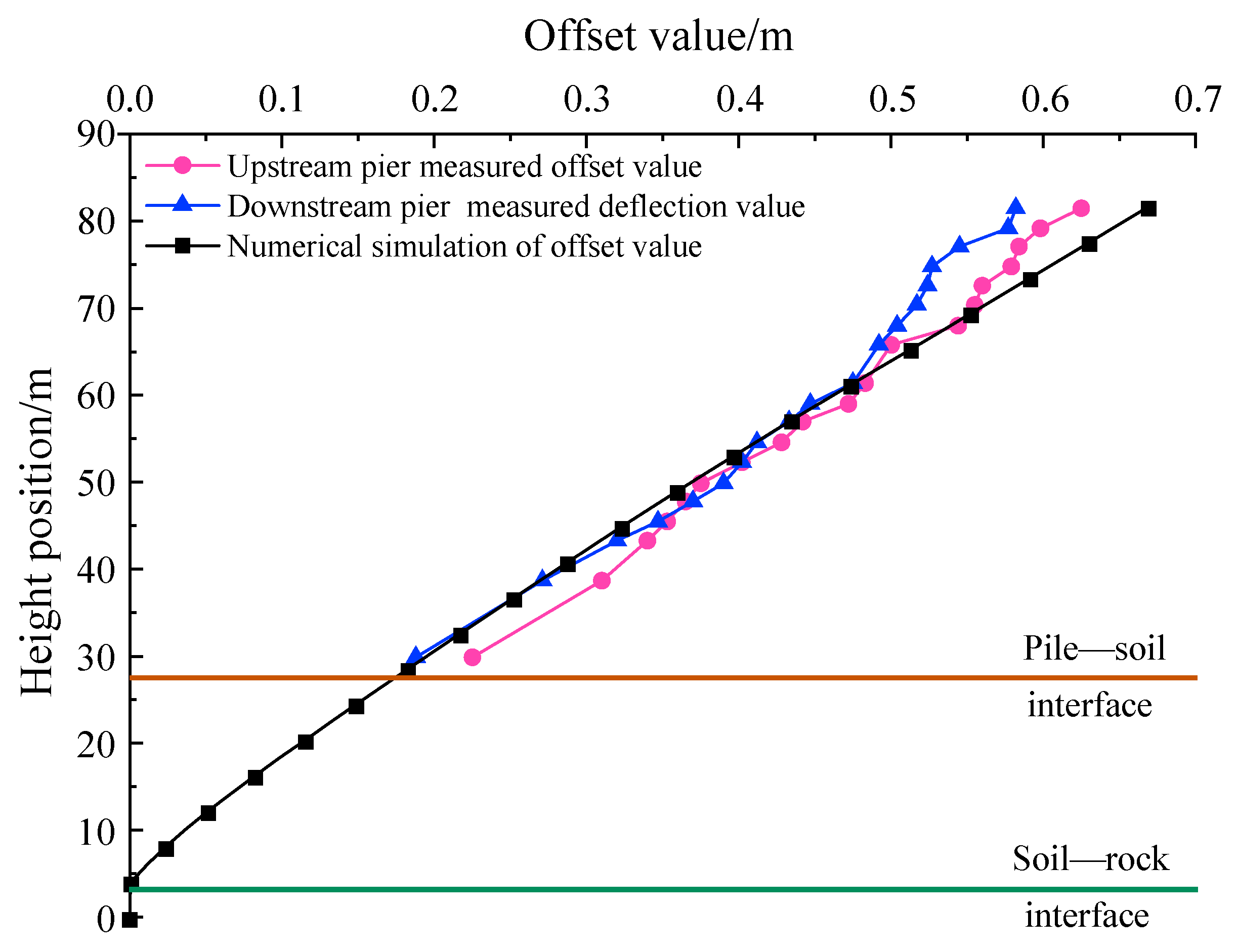
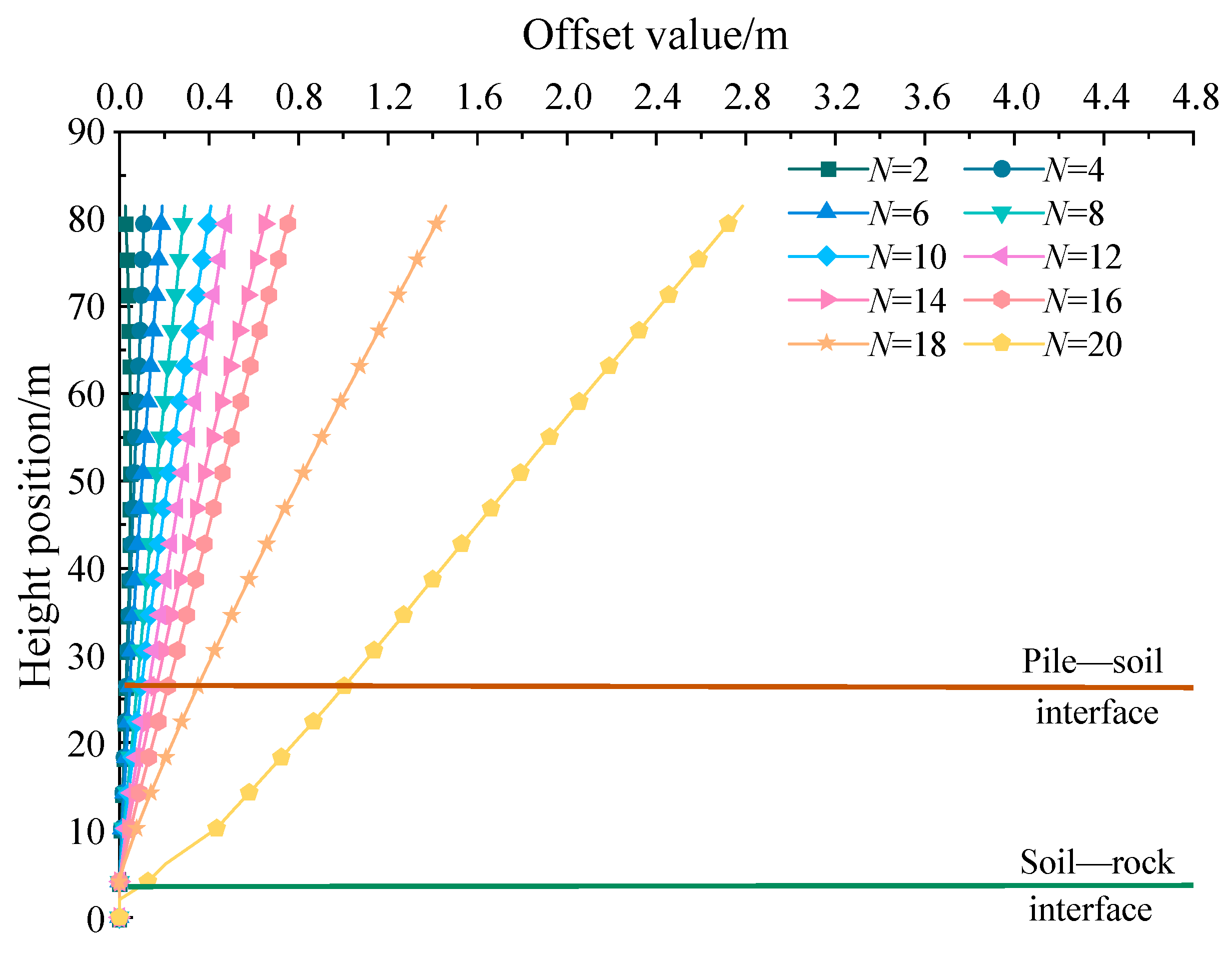

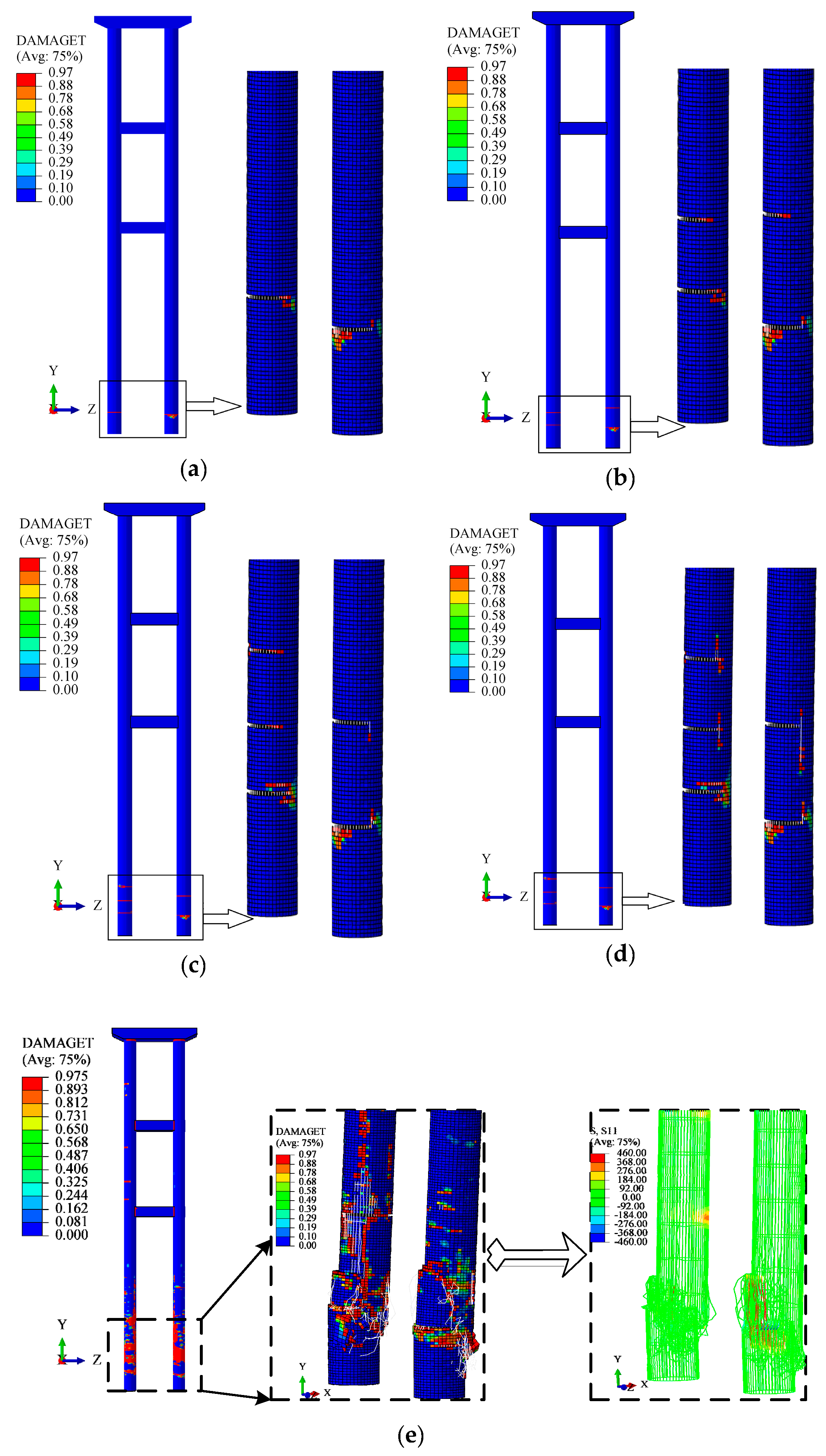
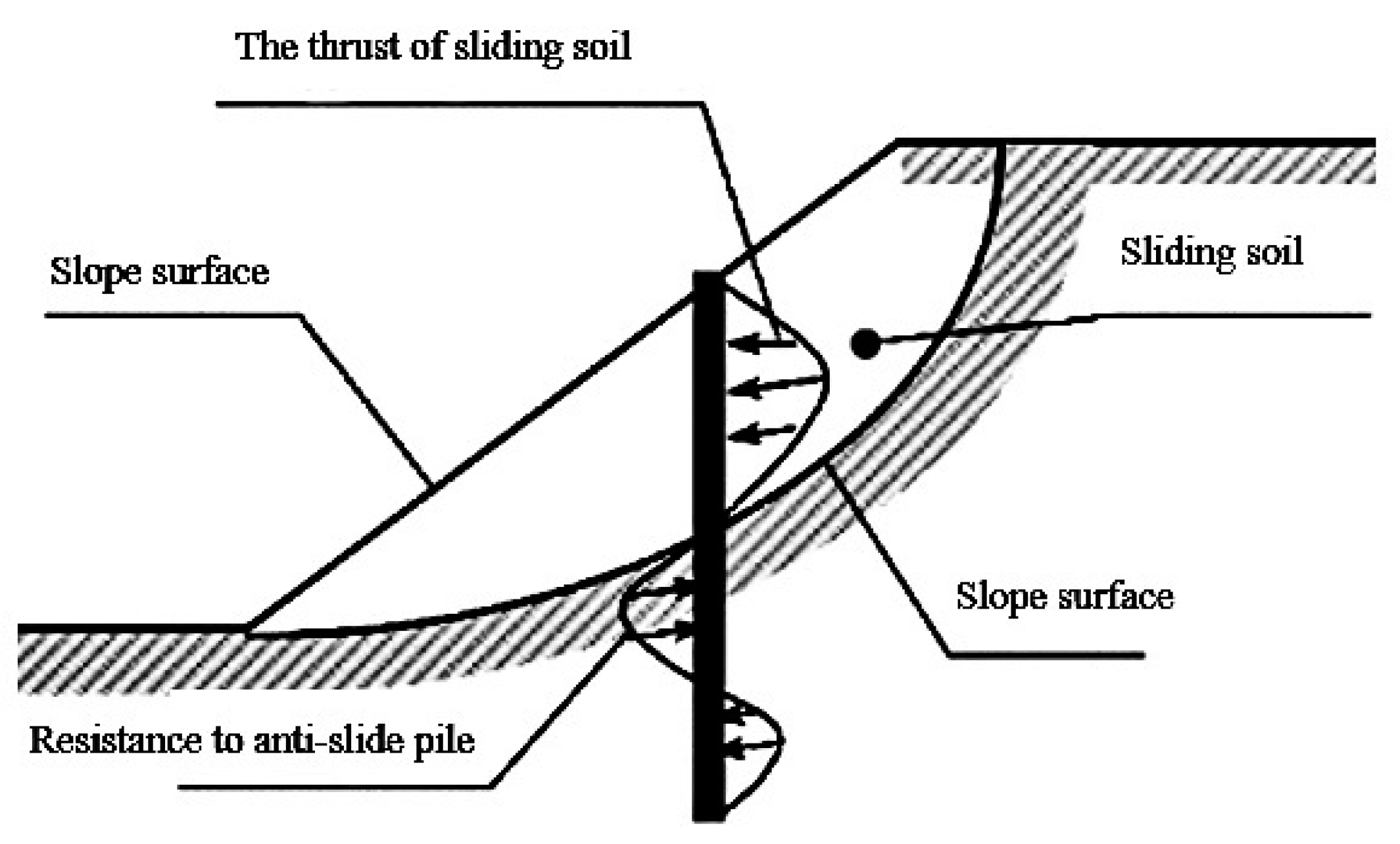
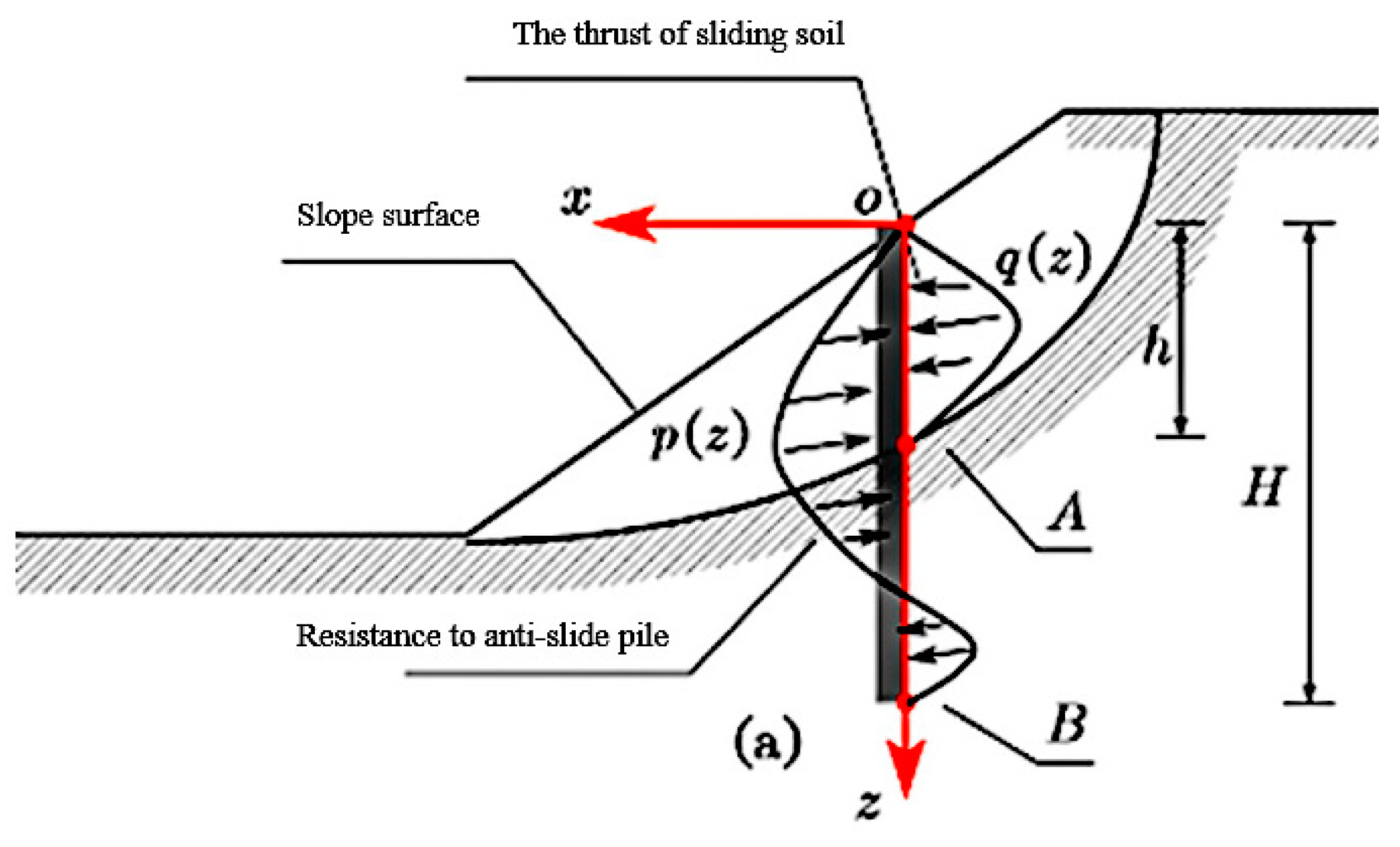
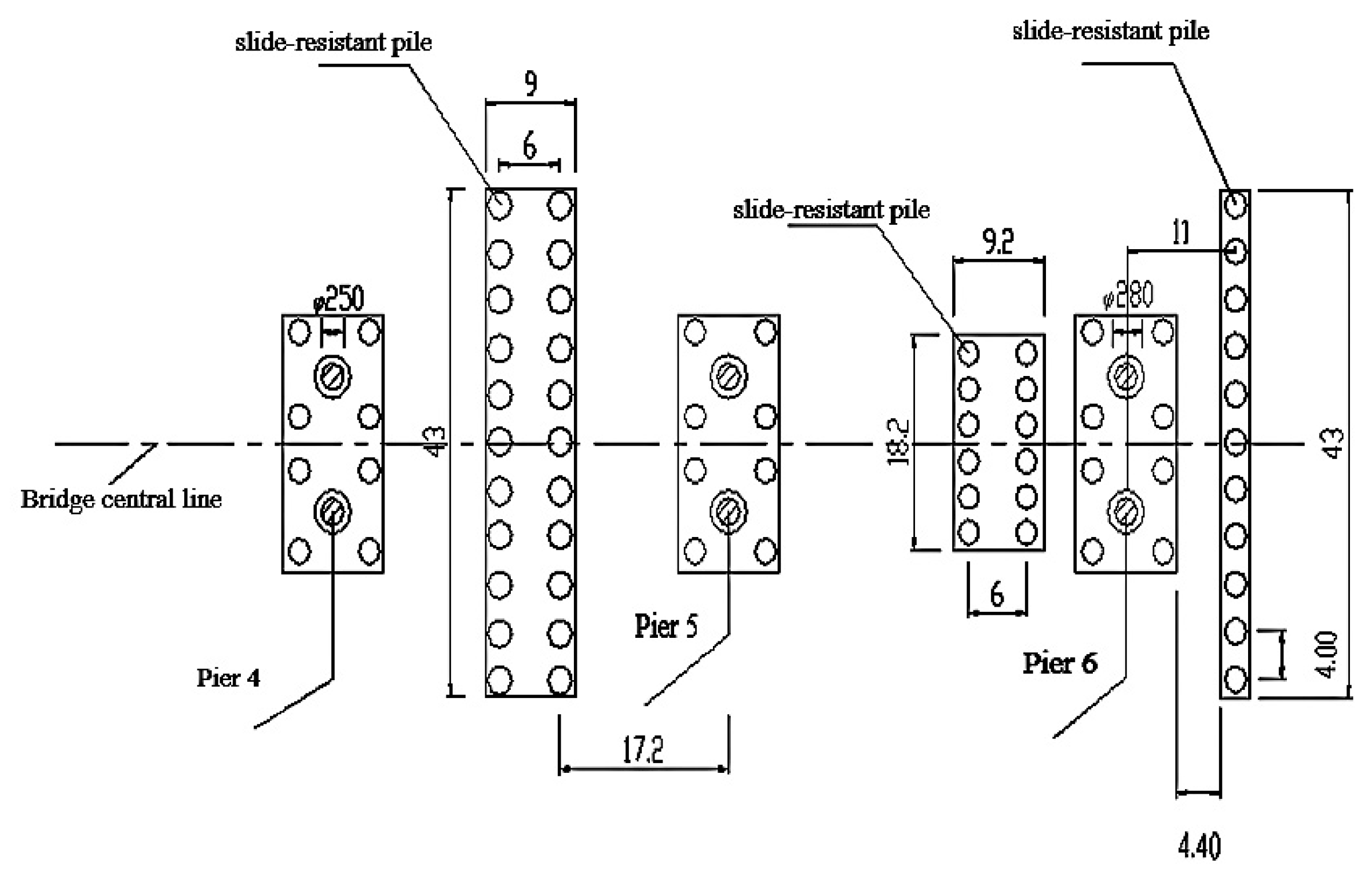


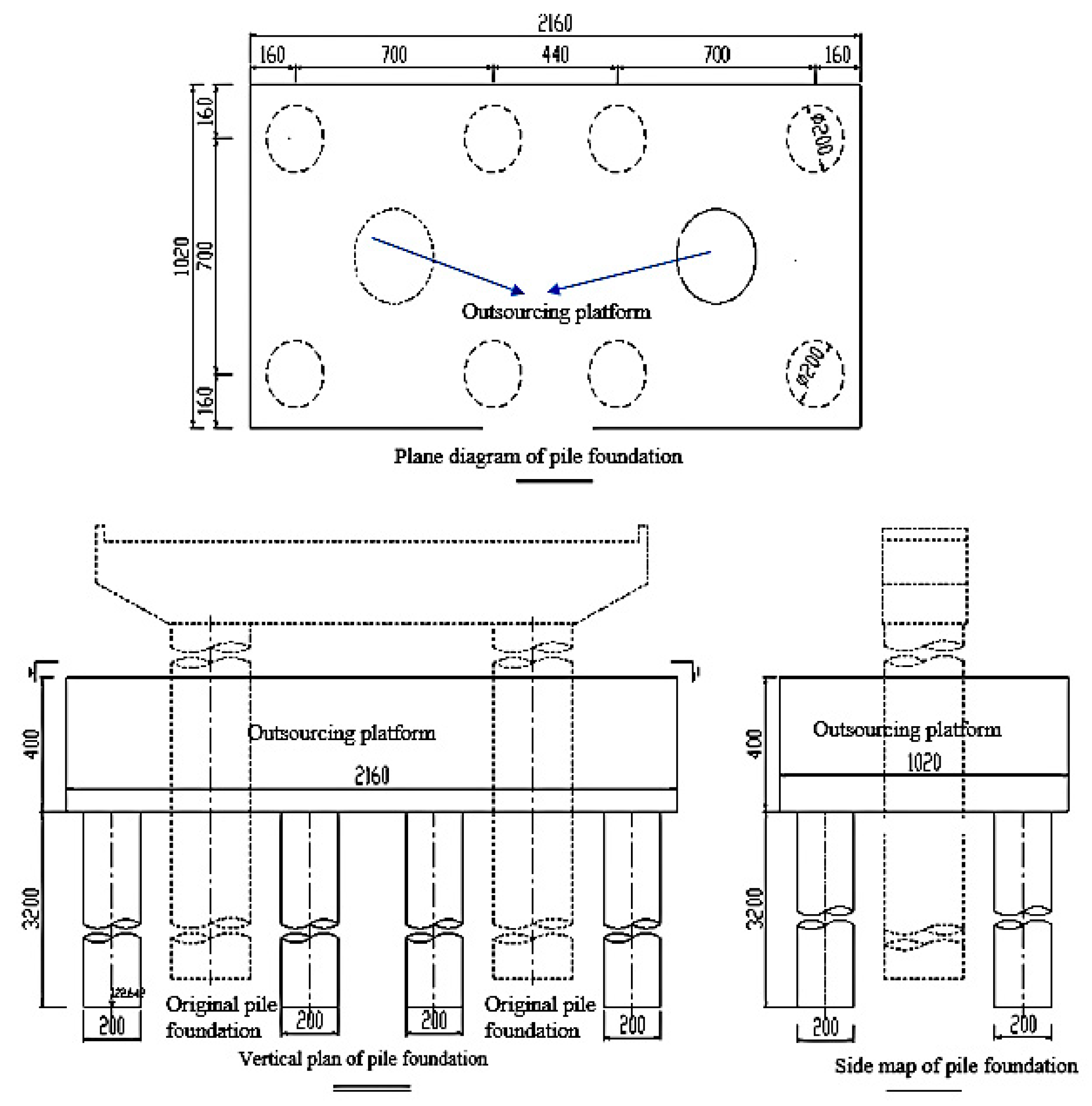
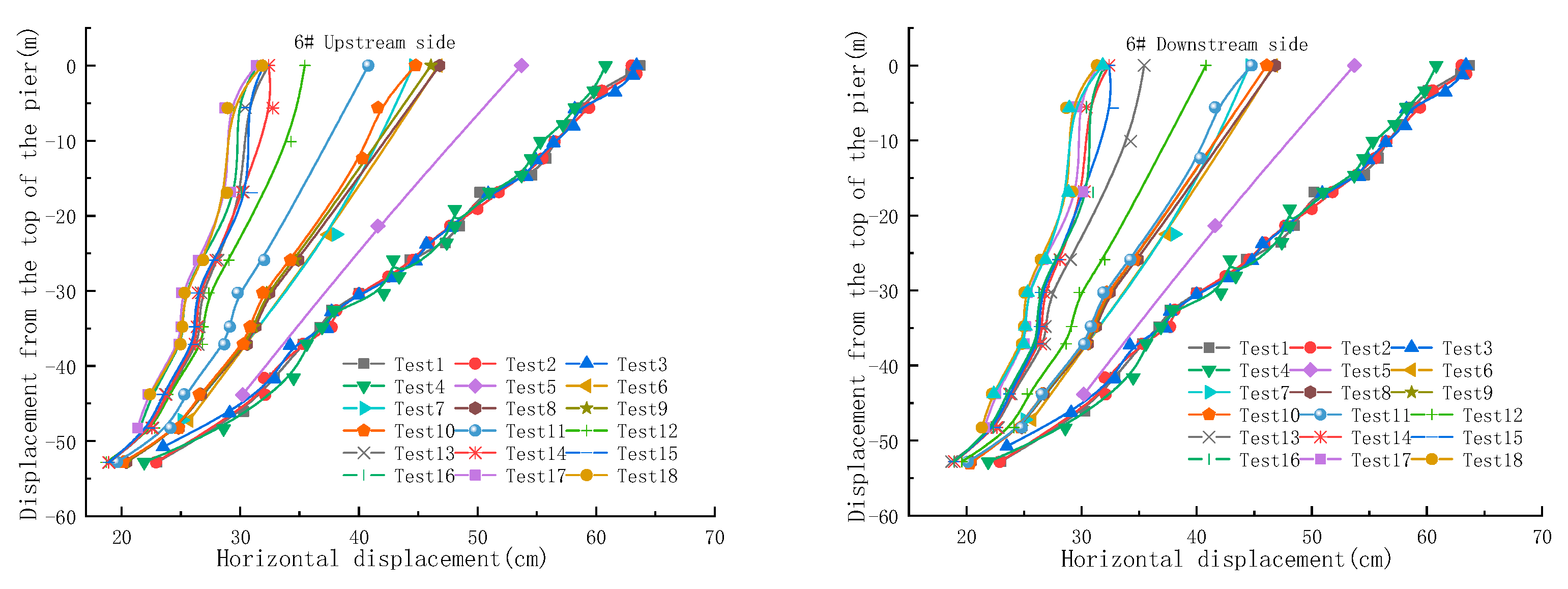
Disclaimer/Publisher’s Note: The statements, opinions and data contained in all publications are solely those of the individual author(s) and contributor(s) and not of MDPI and/or the editor(s). MDPI and/or the editor(s) disclaim responsibility for any injury to people or property resulting from any ideas, methods, instructions or products referred to in the content. |
© 2023 by the authors. Licensee MDPI, Basel, Switzerland. This article is an open access article distributed under the terms and conditions of the Creative Commons Attribution (CC BY) license (https://creativecommons.org/licenses/by/4.0/).
Share and Cite
Li, S.; Yao, G.; Zhang, G.; Wang, W.; Song, A.; Liu, W.; Qin, T.; Zhou, G.; Zhang, L. Study on the Damage Mechanism of Bank Slope-Bridge Pile Foundation Interaction under Reservoir Water Level Cycle. Appl. Sci. 2023, 13, 7014. https://doi.org/10.3390/app13127014
Li S, Yao G, Zhang G, Wang W, Song A, Liu W, Qin T, Zhou G, Zhang L. Study on the Damage Mechanism of Bank Slope-Bridge Pile Foundation Interaction under Reservoir Water Level Cycle. Applied Sciences. 2023; 13(12):7014. https://doi.org/10.3390/app13127014
Chicago/Turabian StyleLi, Shiya, Guowen Yao, Gaofeng Zhang, Wei Wang, Anxiang Song, Wenpeng Liu, Tao Qin, Ganping Zhou, and Leihan Zhang. 2023. "Study on the Damage Mechanism of Bank Slope-Bridge Pile Foundation Interaction under Reservoir Water Level Cycle" Applied Sciences 13, no. 12: 7014. https://doi.org/10.3390/app13127014




